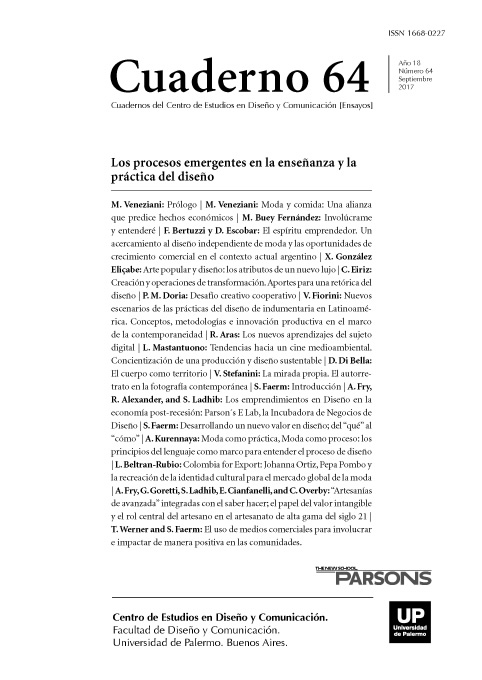Colombia For Export: Johanna Ortiz, Pepa Pombo and the re-creation of the cultural identity for a global fashion market
Abstract
In a moment in time when Colombia seems to be entering a postconflict state after over six decades of violence, Colombian nationals are engaging in the reconstruction of a national identity, especially through cultural production. Colombian fashion designers, creating one of the most visible images of identity –clothing– are an essential part of this process of re-creation of the nation. In this paper, I study the ways in which Johanna Ortiz and Pepa Pombo, two important Colombian designers that are widely known both in the country and abroad, selling their products through high-end international fashion retailers, use traditional elements of the national identity to create a new image of Colombia, as the basis of their creations for export. I study how Johanna Ortiz takes inspiration from the orchid, national flower, and the elements of traditional costume, and how Pepa Pombo borrows hand-woven techniques of textile manufacture and geometric, abstract and tribal patterns in textile design from the indigenous communities. I argue that, in de-constructing the stereotypes that associate these elements with the violent and corrupt ideas of armed conflict and drug cartels, and reinterpreting them in their own design aesthetic, they re-construct the Colombian nation and re-create the national identity under a positive light, thus providing a new image of Colombia both for export and for the Colombian peoples to identify with.
References
ACNUR. (n.d.) Pueblos Indígenas en Colombia. Retrieved from http://www.acnur.org/t3/pueblos-indigenas/pueblos-indigenas-en-colombia/.
Anderson, B. R. O’G. (2006 [1983]). Imagined communities: Reflections on the origin and spread of nationalism. New York; London: Verso.
Barthes, R. (1973). Mythologies. London: Paladin.
Barthes, R. (1990). The fashion system (M. Ward & R. Howard, Trans.). Berkeley: University of California Press. (Original work published 1967).
Barthes, R. (2013). The language of fashion (A. Stafford & M. Carter, Trans.). New York; London: Bloomsbury.
Benjamin, W. (1999). The arcades project (H. Eiland & K. McLaughlin, Trans.). Cambridge, MA; London: Harvard University Press.
Bhabha, H. K. (Ed.). (1995). Nation and narration. New York; London: Routledge.
Cromos. (2010, April 26). Pepa Pombo, con México en el corazón. Retrieved from http://www.cromos.com.co/personajes/perfiles/articulo-pepa-pombo-mexico-el-corazon.
Entwistle, J. (2000). The fashioned body: Fashion, dress and modern social Theory. Cambridge: Polity Press.
Evans, C. (2013). In Fashion cultures: theories, expectations and analysis. New York; London: Routledge. Gracia
Pérez, F. (2011). Hijos de la Madre Patria: El hispanoamericanismto en la construcción de la identidad nacional colombiana durante la Regeneración (1878-1900). Zaragoza: Institución Fernando el Católico.
Hall, S. (1990). Cultural identity and diaspora. In J. Rutherford (Ed.), Identity: Community, culture, difference (pp. 222-237). London: Lawrence and Wishart. Hobsbawm, E. Introduction: Inventing traditions. In E. Hobsbawm & T. Ragner (Eds.), The invention of tradition (pp. 1-14) Cambridge: Cambridge University Press.
Jiménez de Muñoz, E. (2009). La representación del ave símbolo del dios Sua: El dios Sol entre los Chibcha. Bogota: Fundación Universidad de América.
Kaiser, S. (2012). Fashion and cultural studies. London; New Delhi; New York; Sydney: Routledge.
Lakies, C. (2010) Challenging the cultural imaginary: Pieper on how life might live. In New Blackfriars, 91(1035), 499-510.
Leon, S. (2015, March 26). Johanna Ortiz loves Lee Radziwill, loathes tight dresses. W. Retrieved from http://www.wmagazine.com/fashion/2015/03/johanna-ortiz-designercolombia/photos/.
Meléndez, M. (2005). Visualizing difference: The rhetoric of clothing in colonial Spanish America. In R. A. Root (Ed.), The Latin American Fashion Reader (pp. 17-30). Oxford; New York: Berg.
Melo, J. O. (1996). Historia de Colombia: el establecimiento de la dominación española. Bogota: Presidencia de la República; Imprenta Nacional de Colombia. Retrieved from http://www.banrepcultural.org/blaavirtual/historia/hicol/indice.htm.
Moda Operandi. (n.d.) Pepa Pombo: Fall Winter 2016. Retrieved from https://www.modaoperandi.com/pepa-pombo-fw16.
Morace, F. (1993). Contratendencias: Una nueva cultura del consumo. Madrid: Editorial Celeste Ediciones. Museo de Trajes Regionales. (n.d.). Trajes Mestizaje 1850 - 1950. Retrieved from http://museodetrajesregionales.com/exposiciones/mestizaje/.
Pieri, K. (2015, August 5). Brand watch: Swooning for Johanna Ortiz. Harper’s Bazaar. Retrieved from http://www.harpersbazaar.com/fashion/designers/a11711/johanna-ortizfashion/.
Rama, A. (1998). La ciudad letrada. Montevideo: Arca. Renan, E. (1995). What is a nation? (Martin Thom, trans.). In H. K. Bhabha (Ed.), Nation and narration (pp. 8-22). New York; London: Routledge.
de Saussure, F. (1960) A course in general linguistics. London: Peter Owen.
Sommer, D. (1991). Foundational fictions: The national romances of Latin America. Berkeley; Los Angeles; London: University of California Press.
Suárez, J. (2008). “En Átomos Volando”: Transformaciones de la iconografía patriótica en la producción cultural contemporánea colombiana. In Revista Iberoamericana 74 (223), 405-422.
Zimmermann, D. (1998). Identity, context and interaction. In C. Antaki & Sue Widdicombe (Eds.), Identities in talk. London: Sage.
Los autores/as que publiquen en esta revista ceden los derechos de autor y de publicación a "Cuadernos del Centro de Estudios de Diseño y Comunicación", Aceptando el registro de su trabajo bajo una licencia de atribución de Creative Commons, que permite a terceros utilizar lo publicado siempre que de el crédito pertinente a los autores y a esta revista.


